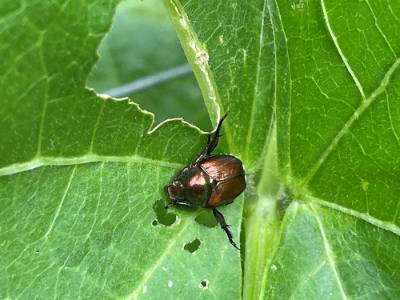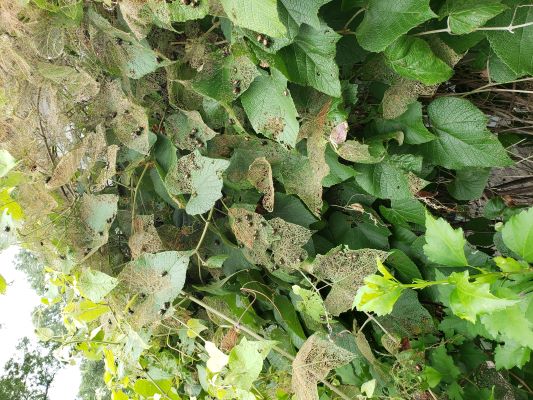Japanese Beetle

These imported beetles originated in Japan (hence the name) where they were only minor pests in their environment. Unfortunately, in the US they are one of the most destructive pests of lawns, gardens and ornamental plants that gardeners deal with. These beetles have a one-year life cycle with the adults hatching in May and laying eggs in July. Adults are less than ½” in length with a metallic green head and a bronze-colored body. The larvae or grub form is white in color and shaped like a “C”. The grubs feed on the roots of lawn grasses under ground during the fall before burrowing deeper in the soil to overwinter. They eventually pupate in late spring before hatching into adults. The adults are equal opportunity feeders but prefer roses, maple trees, grapes, elms and crabapples.
Most healthy plants can withstand a small number of Japanese beetles so general watering and fertilizing will help reduce the impact, however younger plants or vegetable crops can be quickly desiccated if numbers become too high (Like the grapevine in the picture, Photo courtesy of Nancy Gordon). If you have a small number of beetles on your plants, you can pick them off and throw them into a bucket of soapy water. Larger populations of beetles may require some chemical treatment. Neem Oil is an organic option however it only discourages the beetles from eating the plant and needs reapplied frequently, Spinosad is another organic option that kills the adults but again needs to be reapplied frequentl. Products containing permethrin, pyrethrin or carbaryl will all provide a couple weeks control but then will need reapplied. Any spraying should be done early in the morning or late in the evening to prevent harm to pollinators. Traps are not recommended as they attract more insects than enter the traps and can make feeding worse in the area rather then help control the issue.

Grubs are a major issue in some lawns. Most grasses can tolerate up to 10 grubs per square foot, however any number above that will cause dieback and browning of the grass. In heavily infested lawns the grass can be peeled up like a carpet due to grub feeding or it can be torn up by wildlife searching for the grubs. Control of the grubs should begin soon after they start to hatch in the late summer. Preventative herbicides can be applied up to four weeks before the eggs hatch and there are a wide variety of chemical options available. There is a biological option called Milky Spore Disease which has shown limited effectiveness against high populations and can take a while to establish but it only impacts Japanese Beetles and is an organic option. For more information on Japanese Beetles check out this publication: https://bookstore.ksre.ksu.edu/pubs/MF3488.pdf

